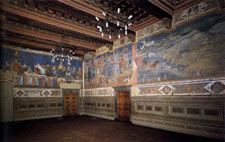
How do we get news of the world? Journalism gives facts, but stripped of emotional nuance and sensual detail. So we read about war, suffering, and death as if they were abstractions, wondering why the terrible statistics slide by with only a small jolt to our awareness.
Art, on the other hand, takes us inside experience and makes us feel it. In Carolyn Forché’s prose poem, “The Colonel,” she speaks of atrocity by narrating a small event. Because of her exquisite skill as a poet, we find ourselves in the same room with evil, forced to contemplate the enigma of human cruelty.
As a writer of creative nonfiction, I believe that the job of the artist is to explore one’s own experience with all the available tools—imaginative, intellectual, and sensual—and to produce work that forges a vivid, urgent connection with reality. Art is the most complete source of news.
The Colonel by Carolyn ForchéWhat you have heard is true. I was in his house.
His wife carried a tray of coffee and sugar. His
daughter filed her nails, his son went out for the
night. There were daily papers, pet dogs, a pistol
on the cushion beside him. The moon swung bare on
its black cord over the house. On the television
was a cop show. It was in English. Broken bottles
were embedded in the walls around the house to
scoop the kneecaps from a man's legs or cut his
hands to lace. On the windows there were gratings
like those in liquor stores. We had dinner, rack of
lamb, good wine, a gold bell was on the table for
calling the maid. The maid brought green mangoes,
salt, a type of bread. I was asked how I enjoyed
the country. There was a brief commercial in
Spanish. His wife took everything away. There was
some talk of how difficult it had become to govern.
The parrot said hello on the terrace. The colonel
told it to shut up, and pushed himself from the
table. My friend said to me with his eyes: say
nothing. The colonel returned with a sack used to
bring groceries home. He spilled many human ears on
the table. They were like dried peach halves. There
is no other way to say this. He took one of them in
his hands, shook it in our faces, dropped it into a
water glass. It came alive there. I am tired of
fooling around he said. As for the rights of anyone,
tell your people they can go f--- themselves. He
swept the ears to the floor with his arm and held
the last of his wine in the air. Something for your
poetry, no? he said. Some of the ears on the floor
caught this scrap of his voice. Some of the ears on
the floor were pressed to the ground.
May 1978, From The Country Between Us, by Carolyn Forché.Note: This is one of a series of poems about Forché’s experience working for Amnesty International in El Salvador in the late 1970s.
[[ Margaret Todd Maitland teaches writing as an adjunct professor in the Liberal Arts Department at MCAD. The former editor of
Ruminator Review, she has received fellowships in creative nonfiction from The Bush Foundation, The McKnight Foundation, The Jerome Foundation, and the Minnesota State Arts Board. She holds an M.F.A. in creative writing from Bennington College.
]]
 HOMO SACER: Sovereign Power and Bare Life by Giorgio Agamben
HOMO SACER: Sovereign Power and Bare Life by Giorgio Agamben










